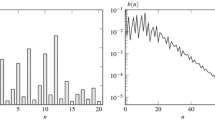Abstract
A combination of discrete-time modelling and theoretical analysis is used to develop an easy-to-use Normal approximation for the time-dependent behaviour of multi-server queueing systems subject to state-dependent balking. Key findings that underpin the approximation are that time lags between peaks in arrival rates and congestion levels can be ignored; queue behaviour is insensitive to distribution of service time beyond its mean; and distribution of number in the system is near Normal. This model is then used to derive valuable management implications for service-orientated systems where delays are frequent and abandonments are an important feature. Key insights are that such systems can often adopt very ‘sub-optimal’ behaviour, and that customer impatience can be very beneficial where management wishes to improve system performance. ‘Optimal’ performance is defined, and practical measures for queue managers to move system performance towards ‘optimality’ are identified.












Similar content being viewed by others
References
Atkinson J (1995). The general two-server queueing loss system: Discrete-time analysis and numerical approximation of continuous-time systems. Journal of the Operational Research Society 46 (3): 386–397.
Chassioti E (2005). Queueing models for call centres. PhD Thesis, Lancaster University.
Chassioti E and Worthington DJ (2004). A new model for call centre queue management. Journal of the Operational Research Society 55 (12): 1352–1357.
Dafermos S and Neuts MF (1971). A single server queue in discrete time. Cahiers du Centre de Recherche Operationnelle 13 (1): 23–40.
Eick SG, Massey WA and Whitt W (1993a). M(t)/G/∞ queues with sinusoidal arrival rates. Operations Research 39 (2): 241–252.
Eick SG, Massey WA and Whitt W (1993b). The physics of the Mt/G/∞ queue. Operations Research 41 (4): 731–742.
Feldman Z, Mandelbaum A, Massey W and Whitt W (2008). Staffing of time-varying queues to achieve time-stable performance. Management Science 54 (2): 324–338.
Galliher HP and Wheeler RC (1958). Nonstationary queuing probabilities for landing congestion of aircraft. Operations Research 6 (2): 264–275.
Gans N, Koole G and Mandelbaum A (2003). Telephone call centers: Tutorial, review, and research prospects. Manufacturing and Service Operations Management 5 (2): 79–141.
Garnett O, Mandelbaum A and Reiman MI (2002). Designing a call center with impatient customers. Manufacturing Service Operations Management 4 (3): 208–227.
Green LV, Kolesar PJ and Soares J (2001). Improving the SIPP approach for staffing service systems that have cyclic demands. Operations Research 49 (4): 549–565.
Green LV, Kolesar PJ and Whitt W (2007). Coping with time-varying demand when setting staffing requirements for a service system. Production and Operations Management (POMS) 16 (1): 13–39.
Griffiths J, Holland W and Williams J (1991). Estimation of queues at the Channel Tunnel. Journal of the Operational Research Society 42 (5): 365–373.
Izady N and Worthington D (2012). Setting staffing requirements for time dependent queueing networks: The case of accident and emergency departments. European Journal of Operational Research 219 (3): 531–540.
Jagermann D (1975). Nonstationary blocking in telephone traffic. Bell System Technical Journal 54 (3): 625–661.
Mandelbaum A, Massey W and Reiman MI (1998). Strong approximations for Markovian service networks. Queueing Systems 30 (1–2): 149–201.
Neuts MF (1973). The single server queue in discrete time-numerical analysis I. Naval Research Logistics Quarterly 20: 297–304.
Samanta S, Gupta U and Sharma R (2007). Analysis of finite capacity discrete-time GI/Geo/1 queueing system with multiple vacations. Journal of the Operational Research Society 58 (3): 368–377.
Seelen LP, Tijms HC and Hoorn MHV (1985). Tables for Multi-server Queues. North Holland: Amsterdam.
Wall AD and Worthington DJ (2007). Time dependent analysis of virtual waiting time behaviour in discrete time queues. European Journal of Operational Research 178 (2): 482–499.
Whitt W (1999). Improving service by informing customers about anticipated delays. Management Science 45 (2): 192–207.
Whitt W (2005). Engineering solution of a basic call-center model. Management Science 51 (2): 221–235.
Whitt W (2006). Fluid models for multiserver queues with abandonments. Operations Research 54 (1): 37–54.
Worthington D (1987). Queueing models for hospital waiting lists. Journal of the Operational Research Society 38 (5): 413–422.
Worthington D (2009). Reflections on queue modelling from the last 50 years. Journal of the Operational Research Society 60 (S1): S83–S92.
Worthington D and Wall A (1999). Using the discrete time modelling approach to evaluate the time-dependent behaviour of queueing systems. Journal of the Operational Research Society 50 (8): 777–788.
Author information
Authors and Affiliations
Corresponding author
Rights and permissions
About this article
Cite this article
Chassioti, E., Worthington, D. & Glazebrook, K. Effects of state-dependent balking on multi-server non-stationary queueing systems. J Oper Res Soc 65, 278–290 (2014). https://doi.org/10.1057/jors.2013.27
Received:
Accepted:
Published:
Issue Date:
DOI: https://doi.org/10.1057/jors.2013.27




